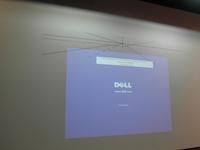
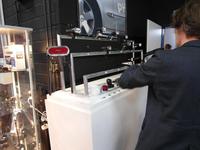
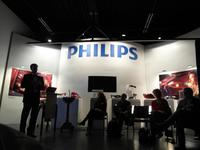
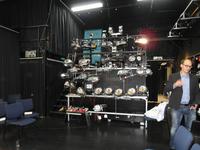
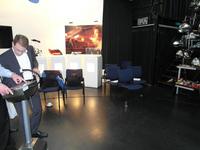
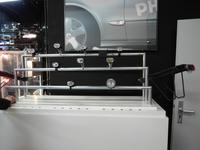
| [ Main index » Bicycle components tests » (Dynamo) bicycle lighting analysis » Philips: Bike lighting day 19 January 2012 | ] |
2012-1-21: Initial peport written up.
2012-2-11: A bit more added about HID/LED beam light colour and doing the same in bike lights...
2012-2-13: Added a reference to StVO about symmetrical beam lamps.
More to come.
I got in Aachen the 18th to have a look around in Aachen, allowing me to do some shopping, but also to be there in time, otherwise I would arrive too late due to the long (4 hour) train journey.
The information, comparisons shown were held the in the test/measurement lab for car and bicycle lamps.
Right at the start I got some questions what my thoughts were about B&Ms new brakelamp from someone working in distribution/marketing. So, I gave some of my views, said that I couldn't test it yet (which I want to do by putting it on a bike, let someone ride and then I will follow) because it's been sold out all the time. He also said that B&M was good at opening up markets, just like with DRL. I told him that B&M, with those 4 LEDs that shine directly into opposing traffic in cone shape in the DRL versions of their headlamps, was going for 'visibility by being annoying'. His response: 'No comment' ;-) Philips didn't think DRL was necessary so that's why it hasn't been introduced in their headlamps.
More to come.
More pictures to come.
More to come.
Pictures to come.
Lots of subjects came up: How to convey the beam quality to buyers, measuring the beam which is done by moving the lamp instead of the sensor, also the sensor is placed in another section separated from the room on the pictures via a tube because car lamps must be measured at 25 m distance and the building they use isn't big enough. An overview of human vision, such as light sensitivity of the human eye decreasing as we age as the lens gets more opaque. Also we can't adjust well to stray light when we get older. Someone else said that we can't adjust well to scattered light going directly into our eyes which is caused (partly?) by the lens getting more opaque (so the light is not just a bright spot in one's vision, but gets to be a wide blob of bright light which obscure other things in that area).
There are probably variations in this as I don't experience any lesser ability in myself to see the road. What I did in the early 1990s, i.e. riding at 45 km/h with a halogen lamp is something I can still do without problem, it just means a lot of effort going into looking very carefully at the road. But it was like that then too. I will think a bit more about the difference then and now and perhaps look into literature to see what's being said there. Btw., in this case of halogen lighting you get to see more from the side of the road that's unlit because your eyes adjust to a fairly low illumination halogen-lamp. I read about this in one of the German bike magazines as well not long ago where they mentioned something like this, I will look it up.
The test lab has a drawing of the cutoff line that you can see in the picture, and an opening where the light goes through a tube to another building where the light sensor is, to measure beam shape. A few different types of headlamp were shown: Standard halogen, HID, and LED based. I commented that the HID and LED beams shown are quite uneven in colour (blue/purplish at the top near the cutoff for the HID, and yellow blotchy for the LED headlamp), not what I would call white light, which the lamps are supposed to put out! Also that this colour is a big annoyance for cyclists. Well, the reply was that this is approved and checks are apparently done in such a way that what is obviously not white on a wallshot, is 'white enough' in the measuring setup (this means measuring a larger area and averaging). I think the rules should be changed to disallow this! Especially because the car makers abuse this. The cause for this problem is in particular chromatic aberation. I wrote a bit about this in some other place on my website. An example was that Mercedes wanted to have a bluish colour around the cutoff so that people who see the beam in the rear view mirror would know it's a Mercedes. A big thumbs down from me for Mercedes! So optics are involved in this colour change, but it was said that there are more possibilities, something to do with the metal part of the light.
About the test lab itself, the people from Philips offer to measure light output, beam pattern from dynamo or battery lamps, but also dynamo's... Not just to me btw., but to those in magazines. They already do this with car headlamps. This is another cool thing to do, to get better articles in magazines, which is especially useful for a complex subject like bicycle lighting.
More to come.
Pictures to come.
Philips uses the same method to measure bicycle headlamps as car headlamps: The sensor stays still, the headlamp is moved/rotated.
To use and measure dynamos they have a setup of 8 different dynamo types of various manufacturers and price ranges.
They have an integrating sphere to measure light output. First an empty measurement is done to get a baseline measurement. Then a measurement is done with the lamp inside the integrating sphere, but with lamp off and a standard light source is shone into the sphere (this is fixed to the sphere). This gives a correction for the measurement when the lamp is on, as the lamp itself will absorb some of the light it shines. Then a measurement is done with the lamp on. All 3 measurements are combined to give the light output of the lamp in lumen.
The HID manufacture is just next to the measurement lab and cameras were not allowed. It was quite interesting walk through a working plant making HID bulbs and to hear about the process to make these lamps. I'd never looked into this as I'm not a car-enthousiast and for bike riding I think HIDs are too fragile, but it was interesting to know! For example how complicated the process is and how the manufacturers demand not a few failures per million, but no failures at all. This is because a car has so many components, that if they have even a few parts per million that will fail within 2 years (minimum EU required warranty duration) that lots of cars will have defects because they consist of so many components.
A few issues came up here too, in the group I sat with. E.g. that some people think the blue LEDs of the LBL/Saferide 80 are a button so they press it and nothing happens. This could be a reason to change the design...
To come.
Pictures to come.
I suggested: Take the Saferide 80, cut off the battery compartment, make a mount such that this small part that's left can be mounted in front of the stem, so that the headlamp essentially disappears from view. Also, a battery could be mounted underneath the stem, and external batteries that are compatible with other brands (or otherwise give the oppurtunity of using your own batteries, just include the right connectors).
The issue of looks came up. Someone from a German newspaper said he liked the Supernova Airstream because of looks and that the cooling ribs look 'cool'. This is a non-issue for me, I want something that is really good, but I said that if you take my idea of cutting off the battery compartment off of the LBL/Saferide 80, then you may need to use cooling ribs ;-) (because in the LBL/Saferide 80 the whole housing acts as a heatsink).
The same guy from the German newspaper is as annoyed as I am about the colour of those HID lights, and wanted to do the same thing in retaliation to BMWs etc. ;-) Actually, I think that's not a bad idea except that you also annoy all cyclists with that...
I wondered about Philips' claim of "1000+ equivalent lumens" that they use on the packaging for the Saferide 80 in the USA. Did they get that from my website? (As I already wrote in August 2010 that I estimated the LBL to be equivalent to a symmetrical lamp of at least 1000 lumen). Well, the number came from Philips' own estimates in the lab, although I suspect the reason they thought of using this in advertising is because I mentioned this on my website :) In any event, my estimate is exactly the same as Philips' estimate. I also talked to an engineer about the light output of the LBL which is said to be at least 270 lm, which of course has been found to be correct in multiple measurements. He said that that was deliberate as he wanted to say things as they are. If you just take theoretical values you lose a lot in lots of stages and you end up with perhaps 50% of the claimed (theoretical without losses) value. And that's true and has been shown to be so with many lamps that have been measured in integrating spheres.
Mountainbike lamps: I suggested using not a symmetric beam, but a beam like in the LBL/Saferide 80, but then add more light above the horizon (the beam should also be wider at long distance btw.). The reason for this is that a proper beam with cutoff is so much more effective than a circular symmetric beam and symmetric beams always have an overexposure of the near field. This would would allow you to see with relatively low power, just as well as far higher power lamps with symmetric beam, and thus either longer runtimes with a given battery, or smaller battery for the same runtime as such a power hungry lamp.
Light colour: I suggested using neutral white LEDs as these give a better view of the road and what's beside it, esp. with roads that are not asphalt or tiles, so for MTB this is also much better. The subject of colour rendering was discussed a bit, and my view is that 6000K is only good if the spectrum is like blackbody radiation (i.e. you would get a distribution as with daylight), but as LEDs don't have this (they have a spike in blue, then a steep dropoff, then a lower but longer bump in the lower frequencies of light, giving a fairly low CRI) you need to lower the LED colour temperature, which gives a better view of the colours you will encounter at night. There isn't so much blue you encounter (almost nothing), but a lot of brown/yellow on the side of the road, or leaves on the road! My suggestion as a test of this was to put various coloured objects on the side of the road at various distances and see how many you can make out with cool and neutral white LED light.
See for more on the issue of LED light colour: LED light colour, CRI and experiments.
The subject of different running times and light intensities came up, what do people prefer? Well, some suggestions were made but I suggested a USB programmable lamp so you could program in the (number of) brightness settings/modes you would want. I then heard that IIRC Niterider does something like this. Well, when using e.g. the H6flex I also think these are just too complex to be programmed with a single button and no display for feedback, and I think USB programmability is the future for all headlamps, even dynamo ones (e.g. for DRL or not, brightness level during the day, how to act with USB power, other things).
Differences between pedelec, fast pedelec, e-bike and the rules these must adhere to: There is a lot of confusion about this, so it was explained along with that which rules are different for the electric/electrically assisted bicycle. Pedelecs only run when pedalling, the standard pedelecs go up to 25 km/h, fast pedelecs go up to 45 km/h but need insurance and these are apparently in a gray area legally. With e-bikes (speed?) you don't need to pedal to ride. In NL there is no category for fast pedelecs and they are not offered here. e-bikes need to adhere to different rules for the headlamp.
This gave rise to some other discussions about StVZO, such as the power limits. The engineer from Philips explained that they had to find out about various issues, and they found that the rules as written are not always taken strictly when approving. Regarding the rules I asked about the taillamp power consumption which drops below 50mA in the Philips Lumiring and in some B&M taillamps: is this ok or does it require special approval? Answer: In taillamps and headlamps, if the lamp gives enough light then the minimum power limit is not an issue. The maximum power limit is an issue so the maximum must be as in StVZO/TA otherwise a lamp won't be approved. I asked about a 12V workaround for power output (as I wrote about on my website long ago) and suggested this would be a way to get more power from a standard dynamo. This is possible, but the engineer from Philips said that the total system must be 6V or the total system will not be StVZO compliant. So a 12V approved headlamp with a 6V approved dynamo is not StVZO/TA compliant. My suggestion, whether or not a mixed system is StVZO compliant, would be that this would be a good system for outside Germany, but also, that they could advertise it with 'Betty power from your dynamo' ;-) [ because as my experiments have shown, a Betty 2011 at 1850 lumen is barely better than a LBL/Saferide 80, so getting the LBL to run at 1A (about 6W) would be at least Betty power for on-road use (the standard LBL runs the LEDs at 0.70A, with a dynamo and good driver you can runn the LEDs at maximum power of 1.00A at about just a bit under 25 km/h) ].
Oh btw., the pedelec lamp will be offered loose for sale from March. Not sure about the E-bike version.
As for the differences in beam pattern:
The subject of symmetrical lamps on your bike and helmet came up. Someone claimed there was no rule in StVZO to disallow them on the helmet, and I said there is almost certainly a rule that disallows them similar to the general rule we have in NL. StVZO doesn't allow them mounted on the bike, and after checking I found that, as expected, there is a rule in Germany as well that disallows helmet lamps on public roads, see further on.
Strong symmetrical lamps are definitely not allowed in NL on public roads due to a general rule that you may not do anything that endangers or even might hinder other traffic. In Dutch law we have the following 'kapstokartikel' (general rule) from the 'Wegenverkeerswet' (rulebook for road use), which states:
DUTCH: "Het is een ieder verboden zich zodanig te gedragen dat gevaar op de weg wordt veroorzaakt of kan worden veroorzaakt of dat het verkeer op de weg wordt gehinderd of kan worden gehinderd." (art. 5 WVW).
Translated:
It is forbidden to behave in such a way that danger is caused on the road, or that danger can be caused, or that traffic is hindered or can be hindered. (article 5 from the rulebook on road use).
Switching on a symmetric beam lamp is at the very least a hinder or it can be a hinder, even when mounted on the helmet, as you may look in the direction of traffic at some point from say an automatic response even if you try to aim away from anyone else. Therefore this general rule explicitly disallows the use of (strong) symmetrical lamps on public roads in NL. It doesn't disallow weak symmetrical lamps such as miniature CR2032 powered headlamps that you wrap around the handlebar for example.
And for Germany, here it is in StVO (not StVZO), which shows that as I expected, it is NOT allowed to use helmet lamps with symmetrical beam on a public road:
§ 17 Beleuchtung:
(6) Suchscheinwerfer dürfen nur kurz und nicht zum Beleuchten der Fahrbahn benutzt werden.
So, lights to look for something (ok, they do not explicitly say helmet lamp, but you know with a searchlight is meant a handheld or helmet mounted torch/flashlight), may only be used briefly and NOT to light up the road to ride on.
The problem of conveying how good a lamp is was discussed, lux alone isn't enough, lumen also not. But accurate lumen values as measured in a proper integrating sphere at least give values that you can compare with anyone else's measurements of other lamps also done with an integrating sphere. This in contrast with the ceiling bounce lux test as used on the MTBR light shootout tests (see the 2012 version here), although it does give quite useful comparisons within that test (the room is essentially used as a sort of uncalibrated integrating sphere). The lumen/lux issue is hard to explain, which is why the top view of beam intensity is used by Philips. I think mentioning the beam reach is also quite a good idea and the values Philips give are close to my own experiences, but perhaps they should also mention an approximate beam width at say 30m distance? (I suggested this earlier, during dinner). Of course the bird's eye view pictures of the beam shapes show the widths but it's good to mention it explicitly in overview tables.
Indicator lamps (for going left/right) were discussed, or rather the question was put 'could they be useful?'. I don't think there was a clear yes/no. I didn't get round to mentioning that these have been introduced already in e.g. Taiwan and weren't very succesful. There is/was a discussion on Linkedin dealing with brake lamps and indicator lamps, which wasn't all that useful except for those references.
I asked about the headlamp mount:
More to come.
Thank you to everyone at Philips for this great opportunity to see the facility and talk with the people in design, engineering and marketing which means it's possible to get insights from all of them at the same time, get an idea of how it all works with tradeoffs, with trying to convince dealers to sell Philips lamps, the problems in finding out what is really required from the rules of StVZO, and finding out more about the reasons for the setup of the Philips testcenter where you can locate dealers to loan out a lamp. This is something very cool, in the same way that I have been doing it with leather bicycle saddles and bicycle lamps. It shows that Philips is really making an effort in the direction that I like, and this day, which they organised to get input on how to improve the lamps is of course also evidence of trying to improve and provide good products and service.
| To email me go to the email page |
Last modified: Mon Oct 14 04:03:42 CEST 2013